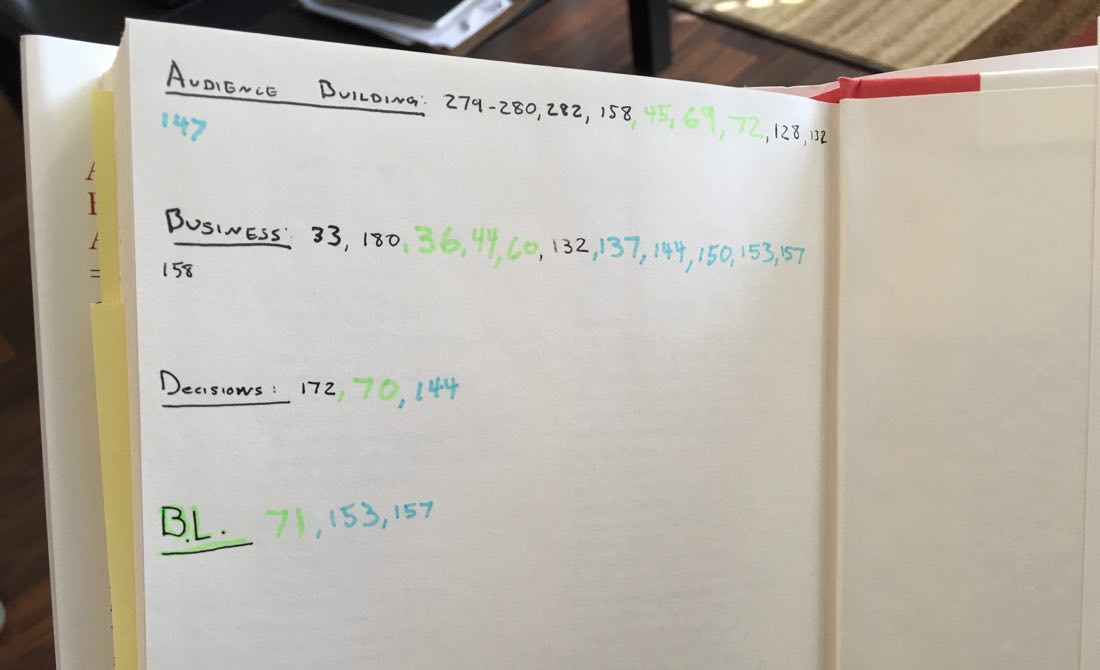About 18 months ago I stopped buying non-fiction books on Kindle.
At first, it was all about the money.
In my research for creating The Focus Course I was buying a slew of books. And used paperback books from Amazon are 50-75% cheaper than their Kindle counterparts.
Of course, it’s not just about the money. Used books also come with their own charm.
Getting a book with someone else’s highlights was a glimpse into what another person had gleaned from the same book I was now reading. Or, sometimes you knew the book had been given to someone because the first page had a note written from one friend to another. Some books were even signed by the author with a brief salutation to the reader — no doubt someone who had waited in line at a book signing.
In addition to the price and the history, buying physical books had another massive advantage:
Physical books are easier to read and digest quickly.
When reading for the sake of learning, it’s more efficient and more effective to have a physical book. For example, you can quickly skim through certain chapters if you want. Or you can jump forward and backward without losing context for where you are in the book.
I especially loved having a dozen books all spread out at once and pulling from different ones as I was working on different topics for The Focus Course.
Recently I picked up another trick for taking better notes within paper books…
An Alternate Index of Ideas
I learned this trick from Maria Popova during her podcast conversation with Tim Ferris. (The part of the conversation where they discuss note-taking begins just past 38-minutes, fyi.)
Your own index is something you put in the back of the book (or the front if you prefer). It’s a list of the book’s themes and topics that most resonate with you, and the pages which have the best quotes and ideas around those topics.
Your index doesn’t even have to fit perfectly in line with the main theme of the book you’re reading.
For example, my index for The Personal MBA includes a topic on Audience Building. Since, for me, that is a critical component to my business. However, there are no chapters or sections specifically about building an audience.
Here’s how to create your own index:
- Start reading the book.
- When you encounter a quote, phrase, statistic, or idea that stands out to you, highlight it.
- Now, think about what the theme or idea this highlight fits in to.
- Go to the back of the book where there will always be a few blank pages.
- Write down the name of the theme or idea.
- Write down the page number of your highlight.
- Return to your spot and continue reading.
Maria Popova says: “It’s an index based not on keywords, but on ideas.”
As I mentioned above, I’ve been working my way through Josh Kaufman’s fantastic book, The Personal MBA. (Speaking of, isn you’re interested at all in business and entrepreneurship, I can’t recommend The Personal MBA enough. It’s a bargain at 10x the price.)
Here’s a photograph of my Alternate Index so far from The Personal MBA:

You can see that so far, the main themes I’ve been taking away from the book are related to: (1) building an audience; (2) business in general; and (3) decision making.
The fourth index item you see — “B.L.” — stands for Beautiful Language.
Beautiful Language is just a catch-all for phrases or quotes that stand out to you but which may not necessarily fit into a particular category of your index.
Here are four phrases I’ve highlighted from The Personal MBA, categorized from my own index of the book:
On Audience Building:
“The more important you make [other people] feel, the more they’ll value their relationship with you. […] The more interest you take in other people, the more important they will feel. […] Make an effort to be present and curious.”
My takeaway: the best way to build an audience is to treat them with appreciation, courtesy, and respect.
On Business:
“Bootstrapping is the art of building and operating a business without funding. […] Having 100 percent ownership and control of a profitable, self-sustaining business is a beautiful thing.”
My takeaway: Building a business is fun and rewarding. It doesn’t have to be about the money. It can be about the work itself.
On Decision Making:
“If you’re a natural maximizer, it’s tempting to overanalyze every decision to make sure you’ve chosen the very best option available, which can easily go well past the point of diminishing returns. Don’t get bogged down with all of the options available — consider only what appear to be the best alternatives at the time of your decision.”
My takeaway: Action brings clarity. Make the best choice I can, then move on and know that I can adjust course and make additional choices in the future.
A great quote (beautiful language):
Your business does not have to bring in millions or billions of dollars to be successful. If you have enough profit to do the things you need to do to keep the business running and make it worth your time, you’re successful, no matter how much revenue your business brings in.
My takeaway: Don’t get so caught up in the building of a business that I lose sight of the bigger picture of living a life without regret, loving my family, and providing real value to others.
* * *
I’ve only recently begun using this Alternate Index approach in the past six months or so. But as I work my way through the queue of unread books on my shelf, I’ll be sure to share more ideas and quotes.